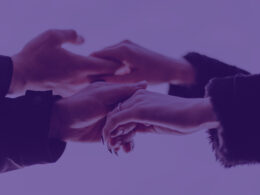Every day, systematic errors in our thought process impact the way we live and work. But in a world where everything we do is changing rapidly—from the way we store information to the way we watch TV—what really qualifies as rational thinking? There really is no right or wrong answer. Here are 50 cognitive biases to guide marketers’ thinking.
In the name of self-awareness, here’s a closer look at three recently discovered biases that we are most prone to exhibiting in the modern world.
Cognitive Bias: Automation Bias
AI-infused applications are becoming incredibly good at “personalizing” our content, but will there come a time when we let algorithms make all of our decisions?
Automation bias refers to the tendency to favor the suggestions of automated systems.
Take Netflix, for example. Everything we see on the platform is the result of algorithms—even the preview images that are generated. Then, to harness the power of data and machine learning, Netflix categorizes its content into tens of thousands of micro-genres. Pairing these genre tags with a viewer’s history allows them to assign several of over 2,000 “taste profiles” to each user.
And while there’s nothing wrong with allowing Netflix to guide what we watch, there’s an enormous sea of content standing by. Estimates from 2015 claimed it would take nearly four years to watch all of Netflix’s content. Thousands more hours of content have since been added.
If we want to counter this cognitive bias, finding a new favorite series on platforms like Netflix may require some good old-fashioned human curiosity.
Cognitive Bias: The Google Effect
Also known as “digital amnesia”, the aptly named Google Effect describes our tendency to forget information that can be easily accessed online.
First described in 2011 by Betsy Sparrow (Columbia University) and her colleagues, their paper described the results of several memory experiments involving technology.
In one experiment, participants typed trivia statements into a computer and were later asked to recall them. Half believed the statements were saved, and half believed the statements were erased. The results were significant: participants who assumed they could look up their statements did not make much effort to remember them.
Because search engines are continually available to us, we may often be in a state of not feeling we need to encode the information internally. When we need it, we will look it up.
– Sparrow B, et al. Science 333, 777 (2011)
Our modern brains appear to be re-prioritizing the information we hold onto. Notably, the study doesn’t suggest we’re becoming less intelligent—our ability to learn offline remains the same.
Cognitive Bias: The IKEA Effect
Identified in 2011 by Michael Norton (Harvard Business School) and his colleagues, this cognitive bias refers to our tendency to attach a higher value to things we help create.
Combining the Ikea Effect with other related traits, such as our willingness to pay a premium for customization, is a strategy employed by companies seeking to increase the intrinsic value that we attach to their products.
For instance, American retailer Build-A-Bear Workshop is anchored around creating a highly interactive customer experience. With the help of staff, children (or adults) can assemble their stuffed animals from scratch, then add clothing and accessories at extra cost.
Nike also incorporates this bias into its offering. The footwear company offers a Nike By You line of customizable products, where customers pay a premium to design bespoke shoes with an extensive online configurator.
While there’s nothing necessarily wrong with our susceptibility to the Ikea Effect, understanding its significance may help us make more appropriate decisions as consumers.
What Can We Do?
As we navigate an increasingly complex world, it’s natural for us to unconsciously adopt new patterns of behavior.
Becoming aware of our cognitive biases, and their implications, can help us stay on the right course.
50 TYPES OF COMMON COGNITIVE BIASES
- Fundamental Attribution Error: We judge others on their personality or fundamental character, but we judge ourselves on the situation.
- Self-Serving Bias: Our failures are situational, but our successes are our responsibility.
- In-Group Favoritism: We favor people who are in our in-group as opposed to an out-group.
- Bandwagon Effect: Ideas, fads, and beliefs grow as more people adopt them.
- Groupthink: Due to a desire for conformity and harmony in the group, we make irrational decisions, often to minimize conflict.
- Halo Effect: If you see a person as having a positive trait, that positive impression will spill over into their other traits. (This also works for negative traits.)
- Moral Luck: Better moral standing happens due to a positive outcome; worse moral standing happens due to a negative outcome.
- False Consensus: We believe more people agree with us than is actually the case.
- Curse of Knowledge: Once we know something, we assume everyone else knows it, too.
- Spotlight Effect: We overestimate how much people are paying attention to our behavior and appearance.
- Availability Heuristic: We rely on immediate examples that come to mind while making judgments.
- Defensive Attribution: As a witness who secretly fears being vulnerable to a serious mishap, we will blame the victim less if we relate to the victim.
- Just-World Hypothesis: We tend to believe the world is just; therefore, we assume acts of injustice are deserved.
- Naïve Realism: We believe that we observe objective reality and that other people are irrational, uninformed, or biased.
- Naïve Cynicism: We believe that we observe objective reality and that other people have a higher egocentric bias than they actually do in their intentions/actions.
- Forer Effect (aka Barnum Effect): We easily attribute our personalities to vague statements, even if they can apply to a wide range of people.
- Dunning-Kruger Effect: The less you know, the more confident you are. The more you know, the less confident you are.
- Anchoring: We rely heavily on the first piece of information introduced when making decisions.
- Automation Bias: We rely on automated systems, sometimes trusting too much in the automated correction of actually correct decisions.
- Google Effect (aka Digital Amnesia): We tend to forget information that’s easily looked up in search engines.
- Reactance: We do the opposite of what we’re told, especially when we perceive threats to personal freedoms.
- Confirmation Bias: We tend to find and remember information that confirms our perceptions.
- Backfire Effect: Disproving evidence sometimes has the unwarranted effect of confirming our beliefs.
- Third-Person Effect: We believe that others are more affected by mass media consumption than we ourselves are.
- Belief Bias: We judge an argument’s strength not by how strongly it supports the conclusion but how plausible the conclusion is in our own minds.
- Availability Cascade: Tied to our need for social acceptance, collective beliefs gain more plausibility through public repetition.
- Declinism: We tent to romanticize the past and view the future negatively, believing that societies/institutions are by and large in decline.
- Status Quo Bias: We tend to prefer things to stay the same; changes from the baseline are considered to be a loss.
- Sunk Cost Fallacy (aka Escalation of Commitment): We invest more in things that have cost us something rather than altering our investments, even if we face negative outcomes.
- Gambler’s Fallacy: We think future possibilities are affected by past events.
- Zero-Risk Bias: We prefer to reduce small risks to zero, even if we can reduce more risk overall with another option.
- Framing Effect: We often draw different conclusions from the same information depending on how it’s presented.
- Stereotyping: We adopt generalized beliefs that members of a group will have certain characteristics, despite not having information about the individual.
- Outgroup Homogeneity Bias: We perceive out-group members as homogeneous and our own in-groups as more diverse.
- Authority Bias: We trust and are more often influenced by the opinions of authority figures.
- Placebo Effect: If we believe a treatment will work, it often will have a small physiological effect.
- Survivorship Bias: We tend to focus on those things that survived a process and overlook ones that failed.
- Tachypsychia: Our perceptions of time shift depending on trauma, drug use, and physical exertion.
- Law of Triviality (aka “Bike-Shedding”): We give disproportionate weight to trivial issues, often while avoiding more complex issues.
- Zeigarnik Effect: We remember incomplete tasks more than completed ones.
- IKEA Effect: We place higher value on things we partially created ourselves.
- Ben Franklin Effect: We like doing favors; we are more likely to do another favor for someone if we’ve already done a favor for them than if we had received a favor from that person.
- Bystander Effect: The more other people are around, the less likely we are to help a victim.
- Suggestibility: We, especially children, sometimes mistake ideas suggested by a questioner for memories.
- False Memory: We mistake imagination for real memories.
- Cryptomnesia: We mistake real memories for imagination.
- Clustering Illusion: We find patterns and “clusters” in random data.
- Pessimism Bias: We sometimes overestimate the likelihood of bad outcomes.
- Optimism Bias: We sometimes are over-optimistic about good outcomes.
- Blind Spot Bias: We don’t think we have bias, and we see it others more than ourselves.
Use our cognitive bias infographic as inspiration for becoming better and knowing more! You can even print it out and use it as a cognitive bias poster to encourage others to do the same.
This article originally appeared in VisualCapitalist. Photo by Mathieu Stern on Unsplash.













